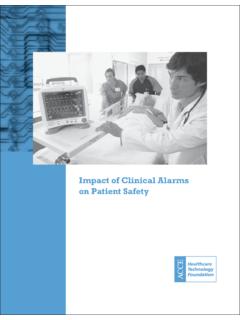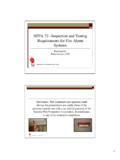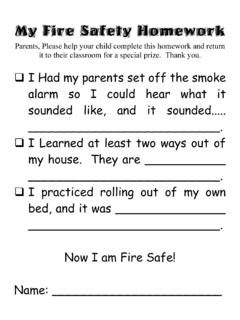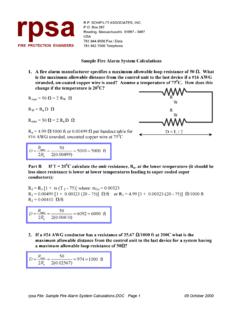Transcription of A Work Plan for The Joint Commission Alarm National ...
1 A Work Plan for The Joint Commission AlarmNational Patient safety GoalWilliam A. Hyman, ScDThe effective use of medical device alarms continuesto be a challenging area. In addition to whatever internalefforts an organization may have currently underway,The Joint CommissionYaccredited institutions must nowcomply with the specific elements of the new NationalPatient safety Goal on Alarm Management. Completingthese elements before the specified deadlines will requireconsiderable effort. A documented and functional planof work will likely be necessary in order to achievesuccess in this effective use of alarms continues to be a challenge inthe clinical setting with respect to how they are selected,set up, and responded to.
2 The Joint Commission (TJC) hasspecifically addressed Alarm management in the past andmore recently with its April 2013 Sentinel Event Alert1(SE) and June 2013 National Patient safety Goal2(NPSG).The latter includes a number of specific steps that TJC-accredited organizations must undertake, along withdeadlines ranging from July 1, 2014, through January 1,2016. There have been a number of educational programsavailable to explain the NPSG including the no-cost As-sociation for the Advancement of Medical Instrumenta-tion and multiple coconveners webinar series, which beganon September 25, is fair to say that these steps are relatively complexand therefore potentially time consuming and human re-source intensive.
3 It is therefore imperative that affectedorganizations establish a compliance development planwith realistic estimates of how long it will take them toundertake and complete the multiple parts of this and supporting activities can also be de-fined, along with the task sequencing necessary to movethrough the necessary steps. With this detailed task defi-nition and associated time estimates, with an appropriateinefficiency multiplier, necessary start dates can in turn beestimated by working backward from the course, one does not have to wait until the deadlineto implement the requirements, and waiting could createrisk management issues. For example, if a required ele-ment is not due until, say, December 2014, but an adverseincident occurs before then that is related to that element,saying that you did not do it because it was not yet re-quired may not be a satisfactory argument.
4 For example,it might be hard to explain why the obvious necessity ofeducating staff and others about the operation of thealarm systems for which they are responsible was not putinto place because it was not required until January , even for hospitals that are not TJC accredited,this new NPSG still provides guidance that can be pointedto as to what constitutes reasonable safety NPSG, as do all TJC standards, sets minimum re-quirements for accreditation. This minimum does notlimit what else might need to be done based on an in-stitution s own self-assessment and experience. In this par-ticular case of alarms, the NPSG does not emphasize thechallenges of communicating alarms to the right caregiverat the right time and ensuring that that caregiver is avail-able and responsive or that the Alarm communication isescalated if not responded to.
5 The NPSG also does notaddress preventive (planned) maintenance activities rela-tive to alarms, nor does it address ongoing monitoring ofalarm utilization and close calls or adverse events. None-theless, what is called for is sensible and, for the most part,what probably should have already been in 1 recasts the elements of the NPSG into a workingdocument that includes the TJC text, a short summarystatement, and the TJC deadline. Given that most or-ganizations would want to have the element completedin advance of the deadline, Table 1 calls for the estab-lishment of an earlier internal or working deadline. Foreach part of the TJC requirement, Table 1 also containssuggestions for a subset of subtasks are not unique, and they can be ad-justed and combined to suit the organization s plans.
6 How-ever, in one form or another, it is important to recognizethat each part, and the respective subparts, of the NPSGis itself a complex undertaking. Thus, for part 1, evenestablishing Alarm safety as a priority can require a se-quence of steps, especially if the establishment is goingFeature ArticleJournal of Clinical author:William A. Hyman, ScD, 185 West End Ave,19F, New York, NY Texas A&M University, College Station and adjunct professor ofbiomedical engineering at The Cooper Union, New author declares no conflicts of : 2014 Wolters Kluwer Health | Lippincott Williams & Wilkins. Unauthorized reproduction of this article is Work PlanTJC TextIn briefDeadlineTaskAssigned toPart 1.
7 As of July 1, 2014, leadersestablish Alarm system safetyas a [critical access] hospital alarmsafety as a priorityTJC: July 1, 2014 Set and track milestonesWorking deadline: Create approval documentObtain approvalDisseminateImplementTrack milestonesReviewPart 2. During 2014, identify the mostimportant Alarm signals tomanage based on the following:Identify mostimportant alarmsignalsTJC: December 2014 Set and track milestonesWorking deadline: Develop written assessmentof all alarms relative to theirrelative from the medical staff andclinical departmentsMedical/clinicalinputWorking deadline: Format and use surveymechanism to obtain necessarymedical/clinical to patients if the Alarm signal isnotattendedtoorifitmalfunctionsRisk analysisWorking deadline.
8 Create Alarm risk tool anduse it to assess each specific Alarm signals areneeded or unnecessarily contributeto Alarm noise and Alarm fatigueEstablish alarmnecessityWorking deadline: Create Alarm necessity surveytool and use it to assessnecessity for each for patient harm based oninternal incident historyUse internal incidenthistoryWorking deadline: Review internal alarmincident best practices andguidelinesReview availablebest practicesWorking deadline: Identify and review 39&Number 1&January/March 2014 Copyright 2014 Wolters Kluwer Health | Lippincott Williams & Wilkins. Unauthorized reproduction of this article is have real meaning and not just be a platitude frommanagement.
9 In this regard, simply saying that it is a pri-ority is not the same as providing the resources necessaryto see that the stated priority is translated into real a new priority activity also raises the ques-tion of how many priorities you can have, especially giventhe dictionary definition of priority as something that ismore important than other things and that needs to bedone or dealt with first. If something new is made apriority, then something else that used to be the prioritymust be made at least secondary, and everything below itpushed down the list in turn. There is also a fundamentalproblem in externally created priorities. Something that isperceived as a National issue may or may not be a localissue, whereas something that is a local issue may or maynot have generated a National priority.
10 Of course, the glibanswer is to do it all, with equal priority, but this ignoresthe reality of limited time and Work Plan, ContinuedTJC TextIn briefDeadlineTaskAssigned toPart 3. As of January 1, 2016,establish policies and procedures(P&P) for managing the alarmsidentified in Part 2 above that, at aminimum, address the following:Establish alarmP&P, includingTJC: January 1,2016 Set and track milestonesWorking deadline: Establish task force to createalarms P&PReviewDocument&Clinically appropriate settings foralarm signalsEstablish settings Working deadline: Subtask: settings&When Alarm signals can bedisabledEstablish disablementrulesWorking deadline: Subtask: disabling&When Alarm parameters can bechangedEstablish changerulesWorking deadline: Subtask.








